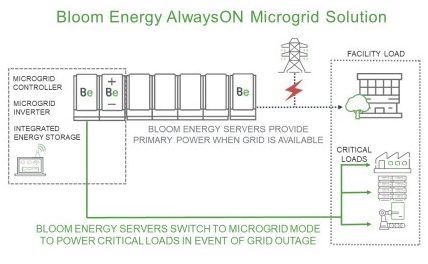by Brianna Crandall — September 4, 2019 — Bloom Energy, a San Jose, California-based provider of microgrids, just announced a new AlwaysON Microgrid solution with attractive financing that is designed to make it easier and more convenient for companies to protect themselves from extended grid power outages and escalating grid electricity rates.
Bloom Energy points out that hundreds of thousands of electric utility customers have been left without power for days at a time this summer as heat waves, storms and wildfire risks have led to extended power outages in California, New York and elsewhere on the Atlantic coast. At the same time, 79 US utilities filed requests to increase electricity rates during 2018, the largest number since 1983, according to a July 19, 2019, report from the US Energy Information Administration (US EIA).
The new AlwaysON microgrid solution is designed to provide customers with a path to energy resiliency in the face of future outages at a predictable cost. Bloom Energy says it has already deployed more than 85 microgrid solutions, which collectively helped customers withstand more than 550 grid outages during 2018.
A microgrid provides electric power and can operate independently of the main electrical grid indefinitely, explains Bloom Energy. Microgrids are an emerging category of technology that the company says have been cumbersome and complex to design and implement. To reduce that complexity, Bloom Energy is now offering a simplified microgrid solution, comprised of a Bloom Energy Server with fully integrated energy storage and the microgrid components needed to power critical facility loads in the event of a grid power outage.
The solution utilizes natural gas or directed biogas supplied through the highly reliable existing underground pipeline system, making it dramatically less susceptible to the impacts of extreme weather, says the company.
KR Sridhar, founder, chairman and CEO of Bloom Energy, remarked:
As the number, severity and duration of climate-related power outages escalates, customers must act to protect their businesses. The Bloom Energy Server can uniquely help them reduce greenhouse gases and secure cost-effective, long-term resilient power in one unified platform.
Bloom Energy Servers generate electricity from natural gas, biogas or hydrogen without combustion through an electrochemical reaction. When operating on natural gas, they generate up to 50 percent fewer CO2 emissions than grid power and produce virtually no particulates and smog-forming emissions. With these sustainability attributes, customers no longer have to choose between sustainability and resiliency — both can be optimized with the microgrid solution, says Bloom Energy.
Bloom Energy has taken a further step to make microgrids more accessible to customers. Contracts for non-utility power typically have long commitments of 15 years or more. It can be challenging for customers to switch to alternative forms of power if they are uncertain whether they will still occupy the same property in years to come, or their business planning does not stretch that long. Now, Bloom Energy is offering energy-as-a-service solutions with terms as short as five years, with no money down, substantially reducing customer commitments.
The Bloom Energy AlwaysON microgrid solution is being introduced as the United States continues to see an escalation of power outages caused by extreme weather events.
The US Energy Information Administration (US EIA) reported on August 1, 2019, that a July heat wave drove the highest electricity demand in nearly two years from the Midwest to the Atlantic coast. Tens of thousands of electricity utility customers lost power for extended periods as a result.
The National Oceanic and Atmospheric Administration (NOAA) Climate Prediction Center announced on August 8 that it expects an “above-average” 2019 hurricane season, with 10 to 17 named storms, five to nine hurricanes, and two to four major hurricanes expected this season. During the 2018 season, hurricanes Michael and Florence left more than 3 million customers without power for up to five days.
Meanwhile, in California, utilities notified customers they may be without power for up to 10 days this summer as a result of efforts to mitigate the risk of wildfires during periods of high wind.
For more information and a video about the Bloom Energy AlwaysON microgrid solution, visit the company’s website. Bloom says its customers include 25 of the Fortune 100 companies and leaders in cloud services and data centers, healthcare, retail, financial services, utilities and many other industries.





